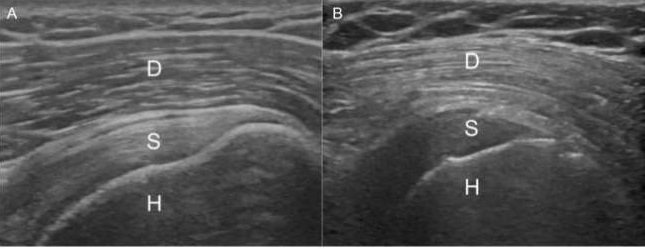
In a new study, researchers found that a shoulder muscle that appears unusually bright on ultrasound may be a warning sign of diabetes.
Ultrasound is commonly used to diagnose sources of pain in the shoulder.
More than 10 years ago, researchers began noticing a pattern when images of the deltoid muscle, the largest muscle of the shoulder, appeared bright on ultrasound.
The observations prompted researchers at Henry Ford to conduct a study to see if the brightness, or echogenicity, of the shoulder muscle, could be predictive of diabetes.
According to the Centers for Disease Control and Prevention (CDC), nearly one in four Americans with diabetes—about 7.2 million people—are unaware they have the disease and are left undiagnosed.
The results revealed that by using the echogenicity of the muscle, radiologists were able to predict type 2 diabetes, the most common type of diabetes, in almost nine out of 10 patients.
Brightness on ultrasound also was an accurate predictor of pre-diabetes, a condition of abnormally high blood sugar that generally progresses to diabetes without changes in lifestyle.
The researchers said the findings could allow for earlier interventions.
For example, if they observe this in patients with pre-diabetes and diabetes, they can get them to exercise, make diet modifications and lose weight.
If these interventions happen early enough, the patients may be able to avoid going on medications and dealing with all the complications that go with the disease.
In the study, the team compiled 137 shoulder ultrasounds from patients with type 2 diabetes, including 13 with pre-diabetes.
The researchers also obtained 49 ultrasounds from obese patients without diabetes.
The researchers showed the ultrasounds to two musculoskeletal radiologists who were unaware of whether the images came from patients with or without diabetes.
The radiologists were asked to classify the patients, based on the brightness of their shoulder muscle, into one of three categories: normal, suspected diabetes and definite diabetes.
A third musculoskeletal radiologist acted as an arbitrator in the cases where the other two radiologists disagreed.
The results showed that a consensus diagnosis of “definite diabetes” by the radiologists was a powerful predictor of diabetic status.
Using the shoulder ultrasounds, the radiologists correctly predicted diabetes in 70 of 79 patients or 89%.
They also found that a hyperechoic, or unusually bright-looking, deltoid muscle was also a strong predictor of pre-diabetes.
The musculoskeletal radiologists assigned all 13 pre-diabetic ultrasounds to either the “suspected diabetes” or “definite diabetes” categories.
The reasons for the brighter-appearing shoulder muscle on ultrasound among patients with diabetes is not completely understood.
But the researchers suspect it is due to low levels of glycogen in the muscle, a key source of energy for the body that is stored primarily in the liver and muscles.
A study of muscle biopsies in patients with diabetes found that muscle glycogen levels are decreased up to 65%.
Prior research has also shown that the muscles of athletes appear brighter on ultrasound after exercise when their glycogen stores are depleted.
It could be that this appearance in people with diabetes and pre-diabetes is related to the known problems with glycogen synthesis in their muscles because of their insulin abnormalities.
If they see a bright shoulder muscle on ultrasound, radiologists at Henry Ford now put notes in their reports indicating that this observation has been linked to diabetes.
The researchers plan to continue studying the connection between shoulder muscle echogenicity and diabetes with an eye toward quantifying the phenomenon and seeing if it is reversible.
Musculoskeletal radiologist Steven B. Soliman, D.O., from Henry Ford Hospital in Detroit, is the lead researcher.
The study is presented at the annual meeting of the Radiological Society of North America (RSNA).
Copyright © 2018 Knowridge Science Report. All rights reserved.
Source: Radiological Society of North America



